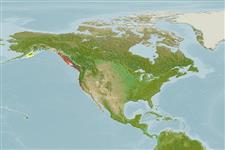Actinopterygii (ray-finned fishes) >
Perciformes (Perch-likes) >
Stichaeidae (Pricklebacks) > Xiphisterinae
Etymology: Xiphister: Greek, xiphos = armed with sword (Ref. 45335).
Environment / Climate / Range
Ecology
Marine; demersal; depth range 0 - 18 m (Ref. 2850). Subtropical, preferred ?; 59°N - 34°N, 156°W - 118°W
Eastern Pacific: Port San Juan, southeastern Alaska to Santa Cruz Island, southern California, USA.
Size / Weight / Age
Maturity: Lm ? range ? - ? cm
Max length : 58.0 cm TL male/unsexed; (Ref. 2850); max. reported age: 11 years (Ref. 56049)
Short description
Morphology | Morphometrics
Dorsal
spines
(total): 71 - 77;
Dorsal
soft rays
(total): 0;
Anal
spines: 0;
Anal
soft rays: 46 - 50. Caudal small and rounded, directed upward; pectorals as minute flaps (Ref. 6885). Greenish black with several dusky white bars on posterior part of body, 2 dark bands diverging back from each eye, each band double with a paler center (Ref. 6885).
Found in rocky areas, from intertidal to 18 m depth, mostly on exposed coast (Ref. 2850). May remain out of water under rocks or seaweed (Ref. 31184). Feed mainly on algae (Ref. 6885). Oviparous, eggs are laid in several clumps or masses which are guarded by the male (Ref. 58332). Breathe air (Ref. 31184) and can stay out of water for 17-23 hours if kept moist (Ref. 51276).
Female lays eggs in a cluster under a rock, male guards the egg mass by wrapping his body around it (Ref. 2850)
Eschmeyer, W.N., E.S. Herald and H. Hammann, 1983. A field guide to Pacific coast fishes of North America. Boston (MA, USA): Houghton Mifflin Company. xii+336 p. (Ref. 2850)
IUCN Red List Status (Ref. 115185)
CITES (Ref. 94142)
Not Evaluated
Threat to humans
Harmless
Human uses
More information
Age/SizeGrowthLength-weightLength-lengthLength-frequenciesMorphometricsMorphologyLarvaeLarval dynamicsRecruitmentAbundance
ReferencesAquacultureAquaculture profileStrainsGeneticsAllele frequenciesHeritabilityDiseasesProcessingMass conversion
Tools
Special reports
Download XML
Internet sources
